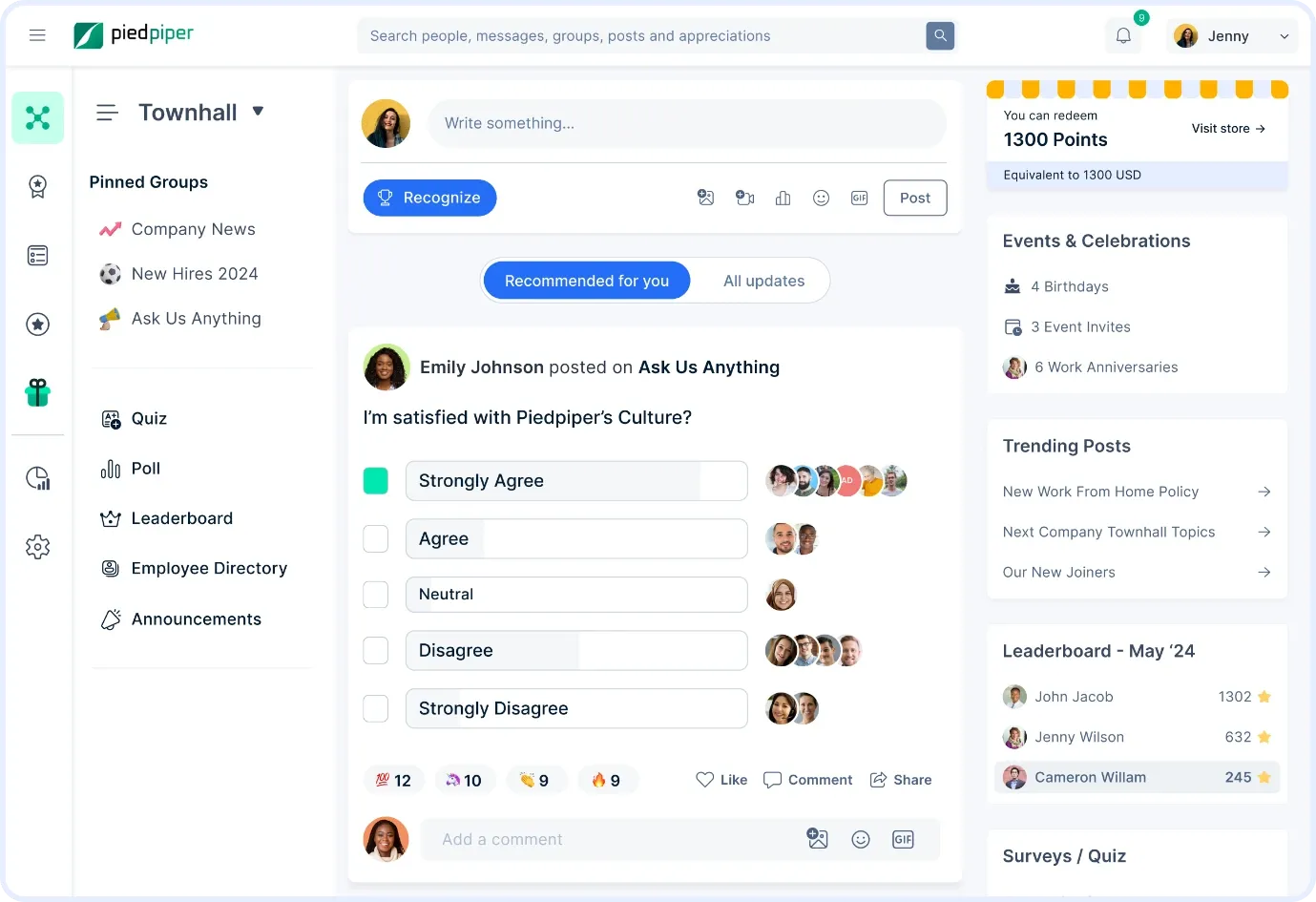10 Smart Time Management Hacks for Busy Professionals to Boost Productivity
Master your workday with these 10 expert-backed time management hacks. Learn how to stay productive, organized, and stress-free in a busy professional world.
On this page
- What is time management and why is it crucial in today’s workplace?
- Why do professionals struggle with managing time?
- When should you start practicing better time management?
- 10 Time management hacks to improve employee productivity
- Who can benefit from these time management hacks?
- How Empuls helps improve time management at work
- Wrapping up
Time is a precious resource for all working professionals. The desire for more than the usual 24 hours a day is a sentiment many can relate to, yet time remains elusive, slipping away relentlessly.
Modern-day professionals face significant time management challenges, especially with the rise of remote work. Surprisingly, research suggests that 82% of working professionals lack an effective time management system. This not only amplifies workplace stress but also spills over into their personal life, leaving individuals feeling overwhelmed.
The issue of time management is not solely an individual concern; it pervades workplaces everywhere. Studies reveal that the average corporate employee spends 51% of their workday on tasks with little to no value.
Employees may be wasting time gossiping with their co-workers or attending workplace celebrations in the physical workplace. On the other hand, in a remote setup, they may be wasting working hours unproductively scrolling on social media.
Given this reality, promoting modern time management practices is imperative in today's workplace. In this blog, we'll explore 10 essential time management hacks to rescue busy professionals and empower them to optimize their time for maximum productivity.
What is time management and why is it crucial in today’s workplace?
Time management is the art of planning, organizing, and executing tasks efficiently to make the most of the limited hours in a day. In today’s digital-first, hybrid work environment, professionals often find themselves struggling to stay focused and productive.
- AI-led nudges to promote healthy time usage
- Employee surveys to identify time-related stress triggers
- Recognition and rewards for efficient and impactful work
Why do professionals struggle with managing time?
Many professionals fall into time traps without realizing it:
- Lack of structure and pre-planning
- Distractions from notifications, meetings, or social media
- Inability to prioritize important tasks
- Perfectionism and procrastination
- Poor sleep or energy management
The modern workplace, whether physical or virtual, is full of interruptions. Recognizing these pitfalls is the first step to overcoming them.
When should you start practicing better time management?
Now. There’s no better time to improve time management than today.
Whether you're feeling overwhelmed, missing deadlines, or just want to improve your focus, starting applying the time management hacks immediately can bring tangible benefits like:
- Increased productivity
- Improved work-life balance
- Reduced stress and burnout
- Better decision-making and focus
Even small tweaks like tracking your day or creating a to-do list can yield major improvements in just a week.
10 Time management hacks to improve employee productivity
Here are 10 time management hacks to improve employee productivity:
1. Conduct a time spend audit
To optimize your time for better productivity, you first need to identify how you currently spend your time. This is where a time-spent audit can help.
You need to diligently track how you spend your time during the average workday. A time spend audit can help you determine:
- What tasks you can feasibly do in a day,
- Identify activities that provide the greatest returns on your efforts and
- Detect any activities or timespans when you could be more productive.
Here are a few steps to help you conduct your time spend audit correctly:
- Log in all activities you perform during the workday and how much time each task takes
- Keep a close eye on your energy levels during the day.
- Rate your energy, mood, motivation, and focus every hour on a scale of 1 to 10.
- Steer clear of external stimulants like caffeine whenever you can.
You need to perform this exercise every day for a week.
Doing this will quickly help you realize how much your time is spent on wasteful activities. You will also get a more precise idea of how long different tasks take you and identify your peak productivity hours. And, by aligning demanding tasks with these prime hours, you can maximize efficiency and meet deadlines effectively.
2. Create a daily schedule in advance
Let’s face it. We are all guilty of wasting time on things that don’t really add value. But have you ever wondered why does it happen? It is because you don’t have a fixed plan or schedule.
A daily schedule with an organized task list can solve this. Scheduling in advance can give direction to the way you approach things and even help with time-blocking. You will feel less anxious and have a clear picture of what lies ahead.
To create a daily schedule:
- Set aside 15-20 minutes before you start your workday to write down your daily goals.
- Use the Pareto 80:20 principle to understand which activities to prioritize. As explained by Brian Tracy, the Pareto principle states that “20 percent of your activities will account for 80 percent of your results."
- Set deadlines for your goals while keeping Parkinson’s Law in mind. This rule states that "work expands to fill the time available for completion." This means that if you set a task deadline strictly rather than liberally, you can still complete it while saving time.
- Follow Eisenhower's Matrix model to boost productivity by categorizing tasks as urgent and important (do immediately), important but not urgent (schedule), urgent but not important (delegate), or neither (eliminate). This method enhances focus on key goals, improving time management and output.
3. Time block and group similar tasks together
Time-blocking is a powerful productivity tool that involves allocating specific times for different tasks throughout the workday. This method helps in reducing distractions and maintaining focus on key priorities.
Setting aside particular times for activities promotes effective time management and ensures that essential tasks are completed efficiently, preventing the feeling of being overwhelmed by conflicting demands.
Here is one of the effective technique for time-blocking:
- Pomodoro technique: A prominent time-blocking technique is the Pomodoro technique, developed in the 1980s. It advocates for concentrated work in 25-minute intervals followed by a 5-minute break. This cycle helps to reduce mental fatigue and maintain high motivation by balancing focused work with regular short breaks. After several Pomodoro cycles, a longer 15-minute break is recommended. You can easily access this pomodoro feature available in almost all time tracker apps.
Alternatively, you can also go for custom time-boxing to set your own pace for tasks. By estimating the time each task might take, you dedicate a specific amount of time to it before moving to the next priority, whether the task is completed or not. This approach helps in adhering to self-imposed time limits and managing the day's workload more realistically.
Time-blocking also prevents distractions from newly emerging tasks during the day. By scheduling specific slots for routine activities like filing, making phone calls, and responding to emails, you can avoid the temptation to check notifications at inappropriate times. This is especially useful during periods of deep work, where focus is crucial.
4. Automate or delegate tasks
Prioritizing certain tasks will make it easier to understand if any tasks can be automated or delegated. This can be especially helpful if you work in a management position.
Many managers unconsciously get into the habit of micro-managing in the workplace, and that is a waste of time for both parties. When you conduct a time audit and follow it up by creating an organized to-do list, you can identify such time-suckers and scale back on tasks that are not a priority for someone in your position.
You can automate non-priority tasks (using tools) or delegate them to another employee, team member, or even a virtual assistant! For example, sending sales emails that mostly read the same can be tedious and consume a lot of time for a sales manager. In such a scenario, they can either automate it using a CRM or email marketing automation software or delegate the task to a junior employee or a freelancer.
5. Identify triggers of procrastination
About 20% of adults are chronic procrastinators, often due to a hyper-focus on perfectionism. Professionals often set high standards for themselves, ultimately leading to them not performing an activity altogether.
How to battle this? The first step is to begin the task without overthinking it too much and breaking the mental barrier to progress. You can use tools like a text to speech reader to process information more efficiently, aiding in task initiation and focus.
Besides this, there are distractions. Here are some common workplace distractions and the best ways to mitigate them:
- Social media: Limit access using website blockers or designate specific break times for social media.
- Meetings: Have clear agendas, limit duration, or use brief stand-up meetings.
- Noisy environments: Use noise-canceling headphones, find quiet spaces, or work during less busy times.
- Constant notifications: Modify notification settings, turn off non-essential alerts, and schedule specific times to check messages.
When limiting distractions, it is best to start with baby steps. For a period of two weeks, identify the two distractions that you find most difficult to overcome. Additionally, a healthy diet, sufficient sleep, and hydration are crucial for maintaining focus, especially when the afternoon slump sets in.
6. Use technology to streamline the workday
Technology is essential to time management because it offers tools and apps that increase productivity, automate repetitive tasks, and allocate time to real priorities.
Based on your needs, here’s a quick recommendation table:
Need | Recommended Tool/Method |
Task Management | Todoist, Asana |
Time Tracking | Time Doctor, RescueTime |
Focus & Deep Work | Forest, Pomodoro Technique |
Team Communication | Slack |
Mindfulness | Headspace |
Automation | Zapier, Email Templates, CRMs |
7. Take sufficient breaks to recharge
While taking a break may sound counterintuitive, studies show that the most productive workers focus on tasks for 52 minutes, followed by a 17-minute break. This quarter-hour window is often called productivity’s “golden hour.”
It lasts just long enough for your mind to switch off to feel rejuvenated, but not so long that you become distracted and lose track of what you are doing.
Frequent breaks improve memory, decision-making, mental health, and productivity, while skipping them can increase stress and hasten burnout. However, using these breaks for merely perusing social media or binge-watching OTT channels is not helpful.
During these windows, you should move your body—stand up from your chair, stretch, reach for a bottle of water, etc. You could also perform smaller jobs that take less than two minutes to complete during these intervals.
To ensure a good sleeping pattern, investing in a quality mattress can be beneficial. You should also:
- Establish a regular bedtime and ensure you sleep for at least 8 hours.
- Avoid using a smart device since the blue light from your smartphone's screen can interfere with your body's sleep cycle.
- Indulge in frequent but brief 15-minute snoozes for an instant productivity boost.
- Avoid caffeine after 5:00 PM, and instead drink a relaxing beverage like chamomile tea.
8. Avoid multi-tasking for increased focus
Multi-tasking might sound like a great tactic for time management in theory, but realistically, it can be very counterproductive. This is because the human brain is not built to focus on multiple activities simultaneously.
You may think accomplishing a set of tasks together will save you time, but our brains switch contexts when we multi-task. Mental juggling results in "switching costs" that reduce output. Even while it might only take a few seconds to switch tasks, if you multitask frequently, the costs pile up. You are also more prone to error risks and a significant slash in productivity in the long term.
9. Learn to say “No” when things become overwhelming
In today's busy professional world, it's crucial to recognize our limited daily energy and the importance of saying no to non-essential tasks. Taking on extra work, especially when facing tight deadlines, can hinder your ability to complete important tasks. Focus on your strengths and, if feasible, assign tasks to others that they can complete more quickly and effectively.
This is a good way to practice mindfulness as a time management hack. You can use mindfulness apps like Headspace to become more aware of your thoughts and responses to certain tasks and stay in the present moment throughout your workday. However, mindfulness as a mindset can be difficult to cultivate for any professional.
Thus, before declining a task, consider its impact on your time and energy, weigh its pros and cons, and assess its relevance to your daily goals. Avoid overthinking or feeling guilty for rejecting tasks that don't add value to your professional life.
10. Keep things organized (and keep them that way!)
Effective time management crucially involves organization. A cluttered desk makes finding necessary items difficult, wasting time and reducing focus. Organizing your workspace and processes boosts productivity, preventing missed deadlines or forgotten tasks.
The good part about this is that organizational skills can be easily learned. Here are some basics:
- Maintain a decluttered desk: Visual clutter can often increase anxiety and stress, setting off a fight-or-flight reaction. Start by shredding or recycling any paper to help you make better decisions. Make room for necessities and place everyday equipment in convenient locations.
- Organize your calendar: You can differentiate and put life buckets on your calendar, like "personal," "professional," and "commitment." color code these to distinguish between categories or between urgent and non-urgent rapidly.
- coordinate shared files using Google Drive: Working in a company means that most files need to be accessed by more than one person. This is where using Google Drive may help. Name files appropriately and establish a structure that will make it simple and quick for you and your coworkers to find them.
- Have separate communication channels: Emails are great, but with evolving technology, you can now converse and update your team members using apps like Slack. Creating separate channels within your Slack workspace for different purposes and departments is advisable.
Who can benefit from these time management hacks?
These hacks are ideal for:
- Remote workers trying to balance home and work
- Managers seeking to delegate or lead efficiently
- Freelancers who juggle multiple projects
- Corporate employees overwhelmed with meetings and deadlines
- HR teams or team leads responsible for productivity training
Anyone feeling stuck in a time loop or looking to improve efficiency can benefit from these strategies.
- Intelligent insights into time usage and recognition gaps
- Automated reward cycles for efficiency achievements
- Slack/MS Teams integrations for in-flow productivity support
How Empuls helps improve time management at work

While individual hacks are essential, lasting impact comes when time management is embedded into the work culture. Empuls helps HR teams, managers, and employees practice effective time management by integrating technology, behavioral nudges, recognition, communication, and insights into the flow of work.
1. Reduce distractions with Empuls social intranet
Eliminate the need for scattered tools. Use Empuls’ social intranet to streamline company updates, townhalls, policy announcements, and employee conversations—all in one place.
Replace time-wasting chatter with focused, high-value discussions via community groups tailored to interests, projects, or departments.
2. Identify time sinks with AI-powered surveys & analytics
Use eNPS, pulse, and lifecycle surveys to discover how employees feel about their workloads, time pressures, or burnout risks.
Track changes and root causes over time with people analytics dashboards, then act on insights with data-backed action plans.
3. Reward productive habits with recognition & nudges
Empuls’ AI bot “Em” nudges employees to log their weekly accomplishments, making it easier for managers to give timely recognition and close visibility gaps.
Reinforce time-smart behaviors (e.g., consistent focus, meeting deadlines, delegating well) with core value badges, spot awards, or custom rewards.
4. Support energy management with perks & benefits
Reduce mental fatigue with perks like discounts on wellness, fitness memberships, and mental health apps.
Offer flexible fringe benefits (like remote work allowances or upskilling reimbursements) so employees can design workdays that optimize their productivity.
5. Automate low-value tasks to free up focus time
Automate greetings, milestones, service anniversaries, and celebration messages with Empuls’ award automation workflows—so managers don’t have to chase reminders.
Free HR teams from manual follow-ups by scheduling year-round reward cycles, notifications, and approval processes.
6. Promote mindfulness with recognition and community culture
Encourage reflection and focus with regular gratitude messages, Wishboards, and community recognition posts—creating a more mindful and appreciative digital workplace.
Wrapping up
As the French philosopher Jean de La Bruyère once said, “Those who make the worst of their time most complain about its shortness.” Time is the most precious resource, and one can greatly enhance one's life by efficiently managing it with time management hacks.
The time management hacks discussed above have proven helpful in breaking old, ineffective habits and developing new, productive ones. Like any other life skill, these incredible methods can only be mastered with perseverance and practice.
However, no pro tip will magically make you a time management expert. To see real change, you need to be aware that time is a limited resource. Build habits of documenting, organizing, and scheduling tasks every day in a way that supports your time management objectives. Also, regularly monitor the time spent performing daily activities to identify any recurring interruptions or changing priorities.
Prioritize time today with time management hacks to become the most productive employee in your organization tomorrow! With deliberate planning, conscious usage, and the right digital support—like what Empuls provides—you can empower your people to own their time, reduce burnout, and drive business success.
Empuls doesn't just offer tools—it enables a cultural shift. One where:
- Employees feel recognized when they use time wisely.
- Managers coach based on insights, not assumptions.
- HR drives organization-wide productivity without burnout.
- Leaders see engagement, retention, and performance soar.
So, what are you waiting for again, schedule a call with our experts, now!













